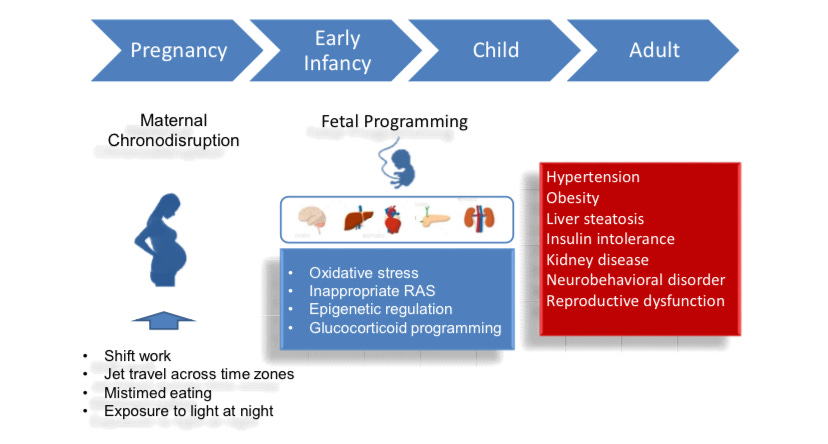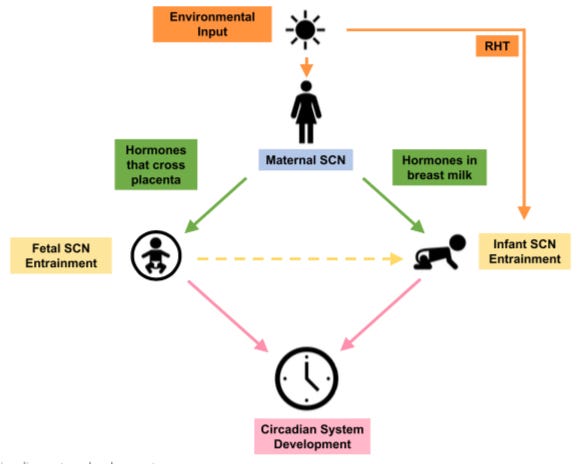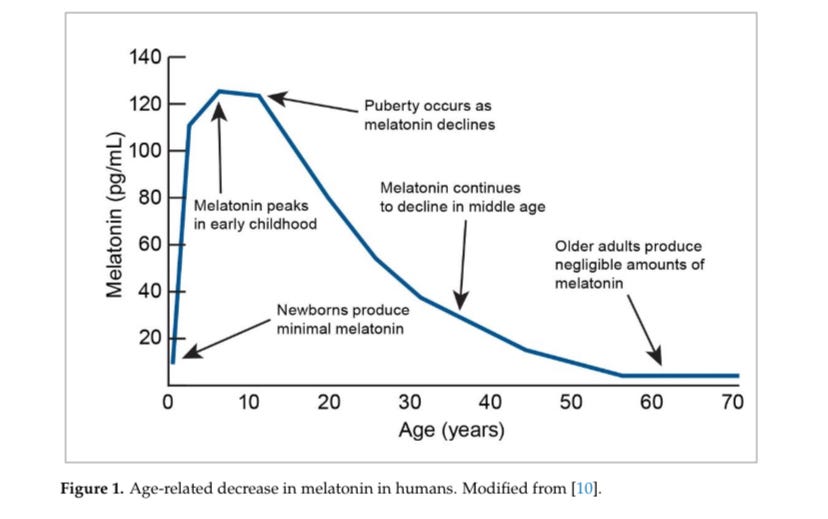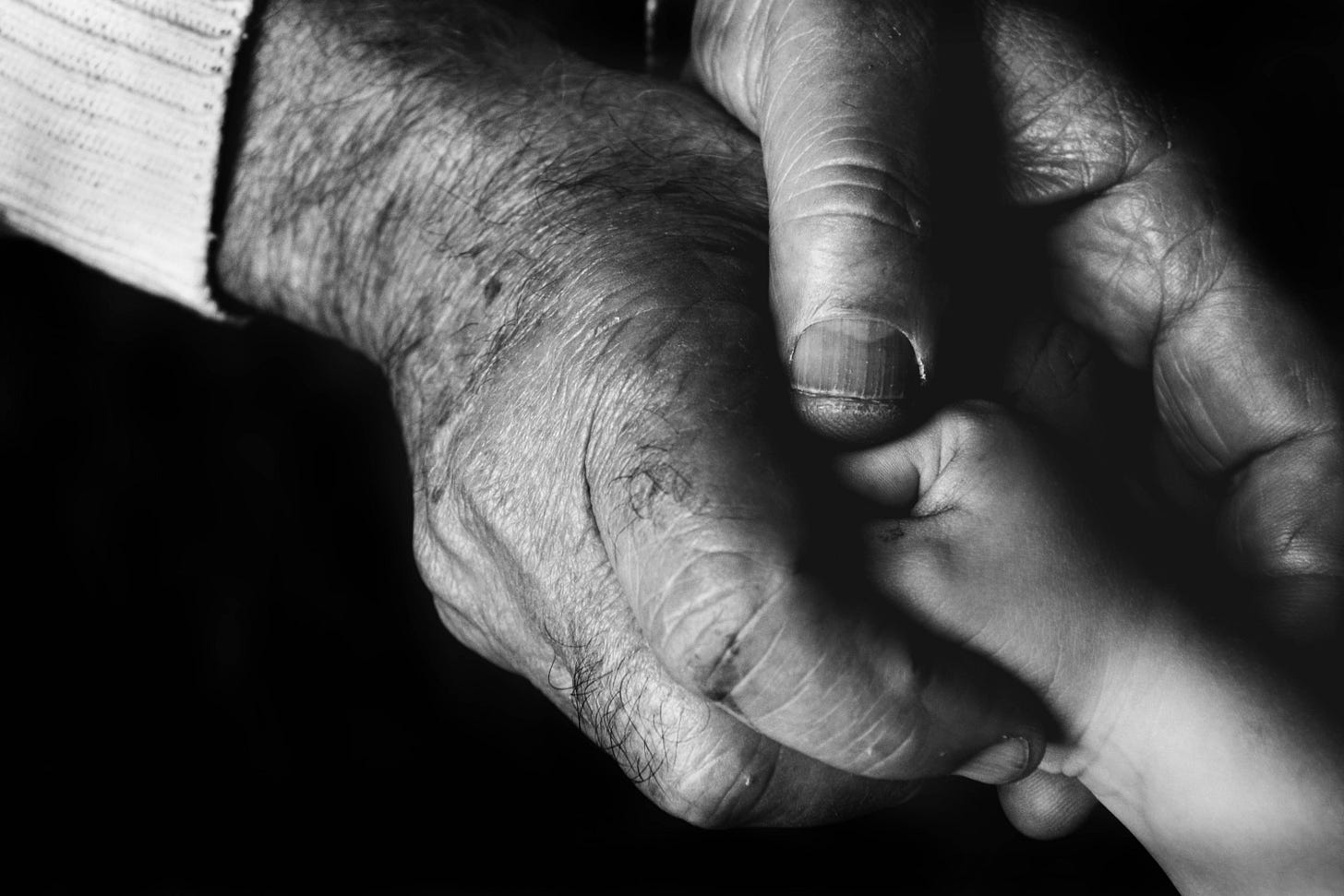Your mother gave you your circadian rhythm
Newborn vs adult rhythms, the circadian programming of disease, and hope for a brighter future for all ages.
Did you know your circadian rhythm is first set by your mother? If your mother and grandmother lived in a healthy light environment, great!
If they had a poor light environment, and if you haven't done the work to reset your rhythm, chances are, you may be carrying those unhealthy patterns today.

Early life (from conception through 2 or 3 years), is when our circadian patterns are first set1.
At birth, we don't have the ability to synthesize significant amounts of the circadian hormone melatonin on our own. Instead, babies get melatonin from breastmilk—particularly from nighttime feeds because melatonin content in breastmilk peaks in the wee hours of the night2. They also get melatonin’s daytime counterpart, cortisol through breastmilk.
This means formula-fed infants are missing out on the melatonin/cortisol oscillation for the beginning of life. (At present, melatonin is not added to infant formula.) With widespread use of artificial light at night, many of today’s mamas are also deficient in melatonin3, leading to melatonin-deficient breastmilk and an overabundance of cortisol—essentially, circadian disruption from the very beginning of life.

Circadian entropy during pregnancy and early childhood is associated with lifelong mental and physical health outcomes4,5. Countless people today suffer from illnesses that may have their roots in early circadian programming.
Signs your mother may have been experiencing disruption include her having had adverse birth outcomes, insomnia or other sleep disorders, and/or hormone-driven cancer.
The good news is if these conditions have their roots in the circadian rhythm, the rhythm can be healed.
To me, this information has huge implications for today's families. What if we could get ahead of all these health troubles for our children? Wouldn't we do whatever it took?
As care providers, there are specific steps we can encourage families to take in order to set their course for circadian resilience.
How to set baby’s circadian rhythms after birth:

Daily, consistent solar exposure in safe doses (be mindful when the UV index is higher than 3 and there is a possiblity of sunburn). The app Dminder can be useful for tracking this.
Sunlight is the primary driver of wakefulness. Increasing a newborn’s daytime wakefulness is the most direct means to entrainment6. There is no risk of sunburn at sunrise or sunset.
Breastfeed, or pump. If pumping, label and give day milk in the day and night milk at night.
Breastmilk contains hormones that fluctuate across the day. It gives cortisol and wakefulness during the day, and sleepy melatonin at night. Getting the right milk at the right time of day ensures baby’s hormonal signals from the milk match the other cues.
Minimize artificial light at night (zero with a blue spike—halogen, fluorescent, “white” LEDs).
Artificial light contains unbalanced frequencies that disrupt maternal rhythms, and when mama’s rhythms are disrupted, so will baby’s be.
Have a consistent family routine.
Newborns rely more on social cues for timing than adults and older children. This may be because they don’t yet have their own daily melatonin pattern to drives their sleep-wake habits.
Ready to dive in to this topic? Take my workshop!
Replay: Circadian Babyhood Workshop
A new baby’s sleep is a vital part of their health, and a powerful indication of their circadian rhythm’s health, too.
Interesting facts about optimizing newborn circadian rhythms:

If possible, parents should start strengthening their circadian rhythms before even trying to conceive, but starting late is better than not at all.
High circulating melatonin during labor is associated with stronger contractions but less pain.
Measurable melatonin production is zero at birth. It begins appearing in saliva at 6 weeks (at the earliest) and peaks in early childhood. After puberty, melatonin declines across the rest of the lifespan.
At present, infant formula does not contain any melatonin and donor milk isn’t labeled as coming from daytime or nighttime. Therefore, only babies that are breastfed receive the positive effects of properly timed melatonin in the early weeks of life.
Getting everything right circadian-wise used to be a given. Before electric lighting, we naturally had to rise and fall with the sun. When we augmented the natural light, it was with flame, which doesn't suppress the rhythm very much. Nowadays, getting outside and nurturing a longer night takes thought and attention. The research clearly shows we have massive gains to make if we take care of the night in a circadian fashion. Each individual, each home, and each community has the chance to bring rhythmicity back.
Post recap:

Our circadian rhythms are first set in the womb, and solidified across the first few years of our lives. Newborns have unique circadian needs because they don't produce melatonin on their own. Without the ability to make melatonin, they rely even more on social cues than grown-ups. This lack of internal melatonin also makes them less susceptible to darkness. Instead, they need more exposure to daytime light to stimulate daytime wakefulness. Additionally, newborns eat around the clock, which would disrupt an adult digestive rhythm. Eating at night doesn't hurt a newborn's rhythm because drinking nighttime breastmilk is exactly how they are meant to get their daily dose of melatonin. Thus, it is important for the mother to have a strong rhythm so she has high melatonin levels in her milk. After all, she is:
Supplying the daily melatonin (and other circadian hormones) for herself and her baby
Providing her baby's main social cues
And represents the most likely opportunity for her baby to get natural light in the day
Yet, the circadian system remains malleable and receptive to entrainment across the lifespan. So, if you have missed this first window for your baby, you can still entrain an older child. And if you are the one suffering from disruption, you can always adjust your lifestyle to entrain your own rhythms to the sun. Just keep in mind that for adults and older children, things are a little different than for newborns. Yes, daytime sunshine will still be the primary force for good. But, for a person with a developed circadian system:
Artificial light at night (ALAN) is the primary disrupter of adult circadian rhythms.
Eating at night is the second most powerful disrupter of adult circadian rhythms.
There may also be some interesting applications to this growing understanding of how melatonin rhythmicity changes across the lifespan for older folks7. See the graph below to understand how melatonin production changes across the lifespan.

In the golden years there are some people (maybe even most in today’s brightly lit world) who no longer produce significant levels of internal melatonin at all. So, in circadian rhythm function we find another way that, as they say, we become again like babies toward the end of life.

Like for babyhood, this research also has implications in how to support people towards end of life. There is a ton of research you can find about circadian rhythms and neurodegenerative diseases if that is something that interests you. And to get you started, I gave a brief overview of the topic of circadian disruption and mental health here:
Minich, D. M., Henning, M., Darley, C., Fahoum, M., Schuler, C. B., & Frame, J. (2022). Is Melatonin the "Next Vitamin D"?: A Review of Emerging Science, Clinical Uses, Safety, and Dietary Supplements. Nutrients, 14(19), 3934. https://doi.org/10.3390/nu14193934






Hmmm I am a great sleeper myself (usually). How do you explain insomnia in pregnancy then? Which I had a lot of. Does that mean my children will be insomniacs later on? They’re both good sleepers though.
This is so interesting. Thanks for sharing!